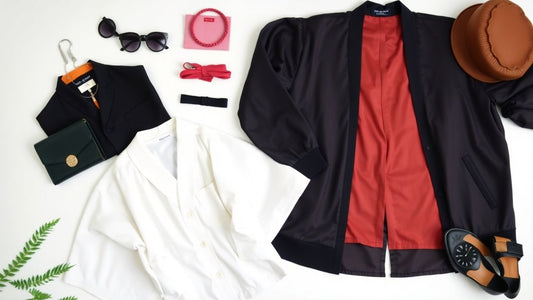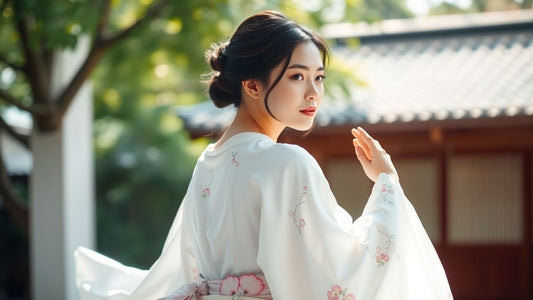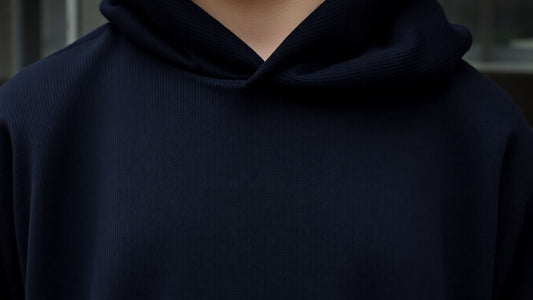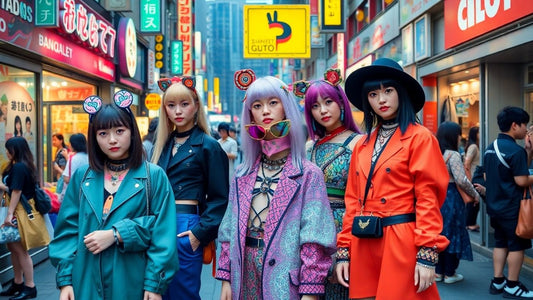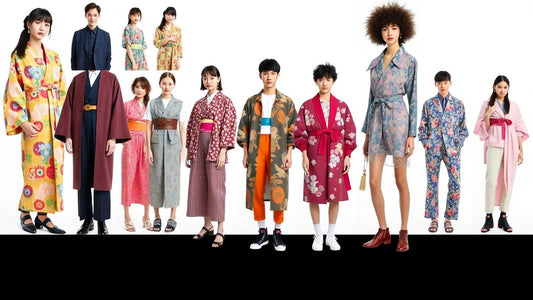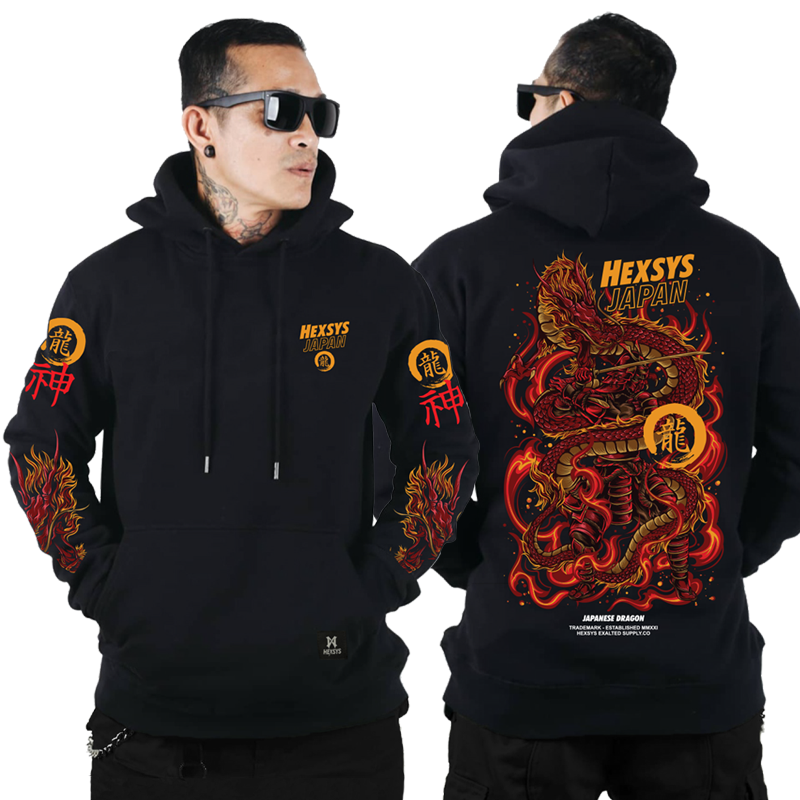Japanese Streetwear - From Subculture to Global Influence
What is Japanese Streetwear?
Japanese streetwear, often referred to as "J-fashion," is a unique and influential fashion movement that originated in the urban youth culture of Japan. It encompasses a diverse range of styles that blend elements of Japanese heritage, pop culture, and avant-garde aesthetics with functional, casual clothing.
At its core, Japanese streetwear is a form of self-expression that challenges traditional fashion norms and embraces individuality. It emerged in the late 20th century as a counterculture movement, driven by young people's desire to rebel against societal conventions and create their own distinct identities.
The origins of Japanese streetwear can be traced back to the post-World War II era, when American culture, particularly in the form of music and fashion, gained popularity among Japanese youth. This exposure to Western influences, combined with Japan's rich cultural heritage, laid the foundation for a unique fusion of styles that would later evolve into the vibrant streetwear scene we know today.
Japanese streetwear is deeply rooted in the country's urban landscape and youth subcultures. It draws inspiration from the bustling streets of cities like Tokyo, where fashion tribes, such as the iconic "Harajuku girls," have become global trendsetters. These subcultures celebrate individuality, creativity, and a DIY (do-it-yourself) aesthetic, often incorporating elements of anime, manga, and video game culture into their fashion choices.
Beyond its aesthetic appeal, Japanese streetwear holds cultural significance as a means of self-expression and rebellion against societal norms. It challenges traditional notions of beauty, gender roles, and conformity, encouraging wearers to embrace their unique identities and push boundaries. This spirit of nonconformity and creativity has resonated with youth cultures worldwide, making Japanese streetwear a global phenomenon.
History and Evolution
Japanese streetwear has its origins in the youth subcultures that emerged in the post-World War II era. As Japan rebuilt and modernized, young people sought to express their individuality and rebellion through fashion. The early streetwear scene drew inspiration from American workwear, military surplus, and countercultural movements like punk and hip-hop.
In the 1970s and 1980s, Japanese designers like Issey Miyake and Yohji Yamamoto pioneered a deconstructed and avant-garde approach to fashion, which would later influence streetwear aesthetics. Brands like Bape (A Bathing Ape) and Undercover emerged, fusing streetwear with high-fashion elements and introducing a unique Japanese sensibility.
The 1990s saw the rise of the "Harajuku" style, named after the famous Tokyo district. This bold and eclectic fashion movement embraced bright colors, eccentric accessories, and a mix of various subcultures like punk, goth, and kawaii (cute). Brands like Comme des Garçons and Neighborhood became popular among the Harajuku youth.
In the 2000s, Japanese streetwear gained global recognition, with brands like Bape, Visvim, and Fragment Design becoming highly coveted worldwide. The influence of Japanese streetwear extended beyond clothing, shaping sneaker culture, music, and art.
Today, Japanese streetwear continues to evolve, blending traditional craftsmanship with contemporary design and pushing boundaries. Collaborations between streetwear brands and high-fashion houses have become common, further blurring the lines between the two worlds.
Key Influencers and Brands
Japanese streetwear has been shaped by a diverse array of designers, labels, and influential personalities. Among the pioneers is Nigo, the founder of A Bathing Ape (BAPE), a brand that became a cultural phenomenon with its distinctive camouflage patterns and ape head logo. BAPE's limited-edition drops and collaborations with musicians and artists fueled its cult following.
Another iconic figure is Hiroshi Fujiwara, often referred to as the "Godfather of Streetwear." Through his brand fragment design, Fujiwara has collaborated with numerous high-end fashion houses, blurring the lines between streetwear and luxury. His minimalist aesthetics and ability to bridge subcultures have made him a revered figure in the industry.
UNDERCOVER, founded by Jun Takahashi, is a brand that seamlessly blends punk, goth, and streetwear influences. Takahashi's avant-garde designs and thought-provoking collections have earned him a dedicated following among fashion enthusiasts and critics alike.
NEIGHBORHOOD, established by Shinsuke Takizawa, is known for its biker-inspired aesthetic and meticulous attention to detail. The brand's collaborations with iconic labels like Adidas and Converse have cemented its status as a streetwear powerhouse.
WTAPS, founded by Tetsu Nishiyama, is renowned for its military-inspired designs and innovative fabric treatments. The brand's emphasis on quality and understated cool has made it a favorite among streetwear enthusiasts worldwide.
Brands like BAPE, fragment design, UNDERCOVER, NEIGHBORHOOD, and WTAPS have not only influenced global streetwear but have also inspired countless collaborations and spin-off labels, further solidifying Japan's position as a leading force in the streetwear movement.
Signature Styles and Aesthetics
Japanese streetwear is renowned for its distinctive and avant-garde aesthetics, blending traditional Japanese elements with contemporary urban influences. One of the most recognizable styles is the oversized, baggy silhouette, often featuring loose-fitting pants, elongated shirts, and voluminous outerwear. This exaggerated proportions create a striking visual impact and allow for layering, a hallmark of Japanese streetwear.
Another signature element is the incorporation of technical fabrics and innovative materials, such as water-resistant nylons, breathable meshes, and performance-enhancing textiles. These materials not only add functionality but also contribute to the futuristic and cutting-edge aesthetic that Japanese streetwear is known for.
Graphic designs and bold prints are also prevalent, with intricate patterns, anime-inspired motifs, and striking typography adorning clothing pieces. These designs often carry deeper cultural or philosophical meanings, reflecting the rich storytelling traditions of Japan.
Color plays a significant role in Japanese streetwear, with a preference for monochromatic palettes or unexpected color combinations. Muted tones like black, white, and shades of gray are frequently used, creating a sleek and minimalist look, while pops of vibrant colors like neon or pastels add a playful and rebellious flair.
Attention to detail is paramount, with intricate construction techniques, unique silhouettes, and unexpected design elements that set Japanese streetwear apart. From asymmetrical cuts and exaggerated proportions to innovative fabric treatments and embellishments, each piece is a work of art that showcases the creativity and craftsmanship of Japanese designers.
Overall, Japanese streetwear is a bold and distinctive fashion movement that celebrates individuality, innovation, and cultural heritage, blending traditional and modern elements into a truly unique and influential style.
Street Culture and Youth Expression
Japanese streetwear fashion has become a powerful vehicle for youth self-expression and the manifestation of various subcultures. At its core, streetwear emerged as a counterculture movement, rebelling against mainstream norms and embracing a bold, individualistic style.
In Japan, streetwear has provided a canvas for young people to showcase their creativity, values, and identities. The eclectic mix of bold graphics, oversized silhouettes, and unconventional materials has allowed Japanese youth to challenge societal expectations and assert their uniqueness.
Many Japanese streetwear brands and designers have tapped into the rebellious spirit of youth subcultures, drawing inspiration from punk, hip-hop, and skate scenes. The raw energy and DIY aesthetics of these subcultures have influenced streetwear's edgy designs, distressed fabrics, and defiant attitudes.
Moreover, streetwear has become a means for Japanese youth to express their interests, hobbies, and passions. From anime and manga-inspired graphics to music-themed collaborations, streetwear has provided a canvas for young people to showcase their cultural affiliations and personal narratives.
Beyond fashion, Japanese streetwear has also fostered a sense of community and belonging among like-minded individuals. Street culture events, such as pop-up markets and fashion exhibitions, have created spaces for young people to connect, exchange ideas, and celebrate their shared love for streetwear.
Overall, Japanese streetwear fashion has emerged as a powerful medium for youth expression, allowing young people to challenge societal norms, embrace their individuality, and connect with like-minded communities through a shared passion for style and culture.
Global Influence and Popularity
Japanese streetwear has transcended its origins and gained a significant global following, influencing fashion trends worldwide. The unique blend of avant-garde designs, bold graphics, and a rebellious spirit has captivated audiences across continents. From the neon-lit streets of Tokyo to the fashion capitals of the world, Japanese streetwear has become a cultural phenomenon.
The rise of social media and the internet has played a pivotal role in the international dissemination of Japanese streetwear. Fashion influencers, bloggers, and enthusiasts have shared their love for these styles, inspiring others to embrace the movement. Collaborations between Japanese brands and international fashion houses have further propelled the trend into the mainstream.
Major cities like New York, London, and Paris have witnessed a surge in the popularity of Japanese streetwear, with dedicated stores and pop-up events catering to the growing demand. Streetwear enthusiasts from diverse backgrounds have embraced the bold aesthetics, incorporating Japanese elements into their personal styles.
Beyond fashion, Japanese streetwear has also influenced other aspects of popular culture, including music, art, and design. Its impact can be seen in music videos, album covers, and even street art, reflecting the movement's transcendence beyond the realm of clothing.
The global popularity of Japanese streetwear is a testament to its unique ability to resonate with individuals seeking self-expression, individuality, and a connection to a vibrant subculture. As the world becomes increasingly interconnected, the influence of Japanese streetwear continues to spread, inspiring fashion enthusiasts and trendsetters across borders.
Fashion Week and Runway Presence
Japanese streetwear has made significant strides in gaining recognition on major fashion runways and events. While initially perceived as a niche subculture, the innovative and boundary-pushing nature of Japanese streetwear brands has captivated the attention of the global fashion industry.
One of the most prominent platforms for Japanese streetwear is Tokyo Fashion Week. This biannual event showcases the latest collections from established and emerging Japanese designers, many of whom have built their reputations on the foundations of streetwear. Brands like A Bathing Ape (BAPE), Undercover, and Neighborhood have become staples at Tokyo Fashion Week, presenting their unique interpretations of streetwear aesthetics on the runway.
Beyond Tokyo, Japanese streetwear has also made its mark at international fashion weeks. Brands like Sacai and Comme des Garçons have become regular fixtures at Paris Fashion Week, blurring the lines between streetwear and high fashion. These brands have challenged traditional notions of luxury fashion by incorporating streetwear elements into their collections, such as oversized silhouettes, bold graphics, and unconventional material combinations.
Moreover, collaborations between Japanese streetwear brands and high-fashion houses have become increasingly common. For instance, the partnership between BAPE and Coach resulted in a highly sought-after capsule collection that seamlessly blended streetwear sensibilities with luxury craftsmanship. These collaborations not only expose Japanese streetwear to a wider audience but also demonstrate the industry's recognition of its cultural significance and design innovation.
Ultimately, the presence of Japanese streetwear on major fashion runways and events has solidified its position as a driving force in the global fashion landscape. By pushing creative boundaries and challenging conventional norms, Japanese streetwear brands have earned a well-deserved place alongside established luxury houses, reshaping the way fashion is perceived and consumed.
Streetwear vs. High Fashion
The boundaries between streetwear and high-end fashion have become increasingly blurred in recent years. Once considered distinct and separate realms, the two worlds have collided, with luxury fashion houses embracing streetwear aesthetics and streetwear brands elevating their designs to haute couture levels.
This convergence can be attributed to several factors. Firstly, the rise of athleisure and casual luxury has made streetwear more acceptable in upscale settings. Designers have recognized the commercial potential of incorporating streetwear elements into their collections, appealing to younger, fashion-forward consumers.
Secondly, collaborations between high-end brands and streetwear labels have become commonplace. These partnerships have allowed both parties to tap into new markets and cross-pollinate their respective styles. For example, luxury houses like Louis Vuitton and Dior have collaborated with streetwear icons like Supreme and Off-White, creating limited-edition pieces that blend high fashion and street culture.
Moreover, streetwear has evolved from its underground roots to become a legitimate force in the fashion industry. Brands like Stüssy, A Bathing Ape, and Palace have cultivated cult-like followings and gained recognition for their innovative designs and cultural influence.
At the same time, high-end fashion has embraced streetwear's emphasis on exclusivity and hype. Limited drops, resale markets, and influencer marketing have become standard practices, blurring the lines between luxury and streetwear marketing strategies.
Ultimately, the fusion of streetwear and high fashion reflects the changing tastes and values of a new generation of fashion consumers. They seek authenticity, individuality, and cultural relevance in their clothing choices, regardless of price point or brand prestige. As the boundaries continue to dissolve, the fashion world is witnessing a democratization of style, where streetwear and high fashion coexist and influence each other in exciting and unexpected ways.
Sneaker Culture and Collaborations
Japanese streetwear has a deep connection with sneaker culture, and collaborations between fashion brands and sneaker companies have become a driving force in the industry. Sneakers are an integral part of streetwear fashion, often serving as a statement piece that complements the overall aesthetic.
The rise of sneaker culture in Japan can be traced back to the late 1990s and early 2000s, when brands like Nike and Adidas began collaborating with Japanese fashion labels and retailers. These collaborations allowed for unique designs and limited-edition releases, fueling a collector's mentality among sneakerheads.
One of the most iconic collaborations is the partnership between Nike and Comme des Garçons, which began in the late 1990s. Their collaborations have resulted in innovative designs that blend streetwear sensibilities with high-fashion elements, creating a unique fusion that resonates with both communities.
Another notable collaboration is between Adidas and Bape (A Bathing Ape), a Japanese streetwear brand known for its distinctive camo prints and ape motifs. Their joint releases have become highly coveted among sneaker enthusiasts and streetwear aficionados alike.
Beyond these long-standing partnerships, Japanese streetwear brands have also collaborated with other sneaker giants like Puma, New Balance, and Asics, resulting in a diverse range of unique and limited-edition sneakers.
These collaborations not only drive hype and demand but also serve as a platform for creative expression and cross-pollination between different subcultures. The fusion of streetwear aesthetics with sneaker design has given rise to new trends and styles, further solidifying the connection between these two worlds.
Moreover, sneaker conventions and events in Japan have become major cultural touchpoints, attracting enthusiasts from around the globe. These gatherings celebrate the intersection of streetwear, sneaker culture, and art, fostering a sense of community and shared passion.
As Japanese streetwear continues to evolve and influence global fashion trends, its connection with sneaker culture remains strong, paving the way for future collaborations and innovative designs that push the boundaries of both industries.
Future Trends and Directions
Japanese streetwear has had a profound impact on global fashion, and its influence is likely to continue shaping future trends. As the culture and aesthetics of streetwear evolve, we can expect to see new directions and innovations emerge from Japan's creative minds.
One potential trend is the fusion of traditional Japanese elements with modern streetwear styles. Designers may draw inspiration from traditional textiles, patterns, and craftsmanship, blending them with contemporary silhouettes and materials. This fusion could create a unique and distinctive aesthetic that celebrates Japan's rich cultural heritage while staying relevant to today's youth.
Sustainability and ethical production practices are also likely to become more prominent in Japanese streetwear. As consumers become more conscious of the environmental and social impact of the fashion industry, brands may prioritize eco-friendly materials, transparent supply chains, and responsible manufacturing processes. This shift could lead to innovative designs and collaborations that prioritize sustainability without compromising style.
Furthermore, the boundaries between streetwear and high fashion may continue to blur, with more crossover collaborations and influences from both worlds. Japanese streetwear brands could explore elevated designs and luxury materials, while high-end fashion houses may incorporate streetwear elements and cater to a younger, more diverse audience.
Technology and innovation will also play a role in shaping the future of Japanese streetwear. Designers may experiment with cutting-edge materials, such as advanced textiles with unique properties or integrated technology for enhanced functionality and style. Virtual reality and augmented reality could also be leveraged for immersive shopping experiences or virtual fashion shows.
Ultimately, Japanese streetwear's future trends will be driven by the creativity, cultural influences, and societal shifts that resonate with the youth culture. As new generations embrace streetwear as a form of self-expression and identity, we can expect to see bold, innovative, and boundary-pushing designs that challenge traditional fashion norms and continue to inspire the global fashion landscape.
